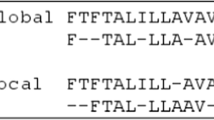Abstract
Multiple sequence alignment (MSA) is a fundamental and challenging problem in the analysis of biologic sequences. In this paper, an immune particle swarm optimization (IPSO) is proposed, which is based on the models of the vaccination and the receptor editing in immune systems. The proposed algorithm is used to train hidden Markov models (HMMs), further, an integration algorithm based on the HMM and IPSO for the MSA is constructed. The approach is tested on a set of standard instances taken from the Benchmark Alignment database, BAliBASE. Numerical simulated results are compared with those obtained by using the Baum-Welch training algorithm. The results show that the proposed algorithm not only improves the alignment abilities, but also reduces the time cost.
Access this chapter
Tax calculation will be finalised at checkout
Purchases are for personal use only
Preview
Unable to display preview. Download preview PDF.
Similar content being viewed by others
References
Du, Z.H., Lin, F.: Improvement of the Needleman-Wunsch algorithm. In: Tsumoto, S., Słowiński, R., Komorowski, J., Grzymała-Busse, J.W. (eds.) RSCTC 2004. LNCS (LNAI), vol. 3066, pp. 792–797. Springer, Heidelberg (2004)
Zhang, F., Qiao, X.Z., Liu, Z.Y.: Parallel divide and conquer bio-sequence comparison based on Smith-Waterman algorithm. Science in China Series F-Information Sciences 47(2), 221–231 (2004)
Thompson, J.D., Higgins, D.G., Gibson, T.J.: CLUSTAL W: improving the sensitivity of progressive multiple sequence alignment through sequence weighting, position-specific gap penalties and weight matrix choice. Nucl. Acids Res. 22, 4673–4680 (1994)
Goto, O.: Optimal alignment between groups of sequences and its application to multiple sequence alignment. Comput. Appl. Biosci. 9, 361–370 (1993)
Williams, A., Gilbert, D.R., Westhead, D.R.: Multiple structural alignment for distantly related all beta structures using TOPS pattern discovery and simulated annealing. Protein Engineering 16(12), 913–923 (2003)
Shyu, C., Foster, J.A.: Evolving consensus sequence for multiple sequence alignment with a genetic algorithm. In: Cantú-Paz, E., Foster, J.A., Deb, K., Davis, L., Roy, R., O’Reilly, U.-M., Beyer, H.-G., Kendall, G., Wilson, S.W., Harman, M., Wegener, J., Dasgupta, D., Potter, M.A., Schultz, A., Dowsland, K.A., Jonoska, N., Miller, J., Standish, R.K. (eds.) GECCO 2003. LNCS, vol. 2724, pp. 2313–2324. Springer, Heidelberg (2003)
Edgar, R.C., Sjolander, K.: Sequence alignment and tree construction using hidden Markov models. Bioinformatics 19(11), 1404–1411 (2003)
Otterpohl, J.R.: Baum-Welch learning in discrete hidden Markov models with linear factorial constraints. In: Dorronsoro, J.R. (ed.) ICANN 2002. LNCS, vol. 2415, pp. 1180–1185. Springer, Heidelberg (2002)
Kennedy, J., Eberhart, R.: Particle swarm optimization. In: Proceedings of the IEEE International Conference on Neural Networks, vol. 4, pp. 1942–1948. IEEE press, Piscataway (1995)
Shi, Y., Eberhart, R.: A modified particle swarm optimizer. In: IEEE World Congress on Computational Intelligence, pp. 69–73. IEEE press, Piscataway (1998)
Verkoczy, L.K., Martensson, A.S., Nemazee, D.: The scope of receptor editing and its association with autoimmunity. Current opinion in immunology 16(6), 808–814 (2004)
Chao, C.C., Yao, Y.L.: Hidden Markov models for the burst error statistics of Viterbi decoding. IEEE Transactions on Communications 44(12), 1620–1622 (1996)
Thompson, J., Plewniak, F., Poch, O.: A comprehensive comparison of multiple sequence alignment programs. Nucl. Acids. Res. 27(13), 2682–2690 (1999)
Author information
Authors and Affiliations
Editor information
Editors and Affiliations
Rights and permissions
Copyright information
© 2005 Springer-Verlag Berlin Heidelberg
About this paper
Cite this paper
Ge, HW., Liang, YC. (2005). A Hidden Markov Model and Immune Particle Swarm Optimization-Based Algorithm for Multiple Sequence Alignment. In: Zhang, S., Jarvis, R. (eds) AI 2005: Advances in Artificial Intelligence. AI 2005. Lecture Notes in Computer Science(), vol 3809. Springer, Berlin, Heidelberg. https://doi.org/10.1007/11589990_78
Download citation
DOI: https://doi.org/10.1007/11589990_78
Publisher Name: Springer, Berlin, Heidelberg
Print ISBN: 978-3-540-30462-3
Online ISBN: 978-3-540-31652-7
eBook Packages: Computer ScienceComputer Science (R0)




